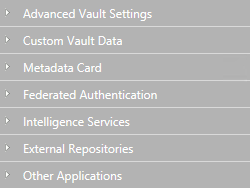Configuration Options for the "Send and Save to M-Files" Button
Using Custom Vault Data, you can add the Send and Save to M-Files button to the Microsoft Outlook composer window on all client computers, or disable the Send and Save to M-Files button altogether. For more information on the Send and Save to M-Files function, see Functions in Microsoft Outlook.
Complete the following steps to configure the Send and Save to M-Files button for all client computers:
-
-
Select .
- Expand the Namespaces node, select Add Namespace, and expand the newly added namespace node.
- In the Group field, enter an internal name of your choice for the group that uses the namespace that you are about to register.
- Use the Storage Type drop-down menu and select MFConfigurationValue.
- In the Namespace field, enter the namespace M-Files.Core.Client.Settings, and in the Namespace Label field, enter a custom label for the namespace shown in the Custom Vault Data configuration.
- In the Namespace Description field, enter a description about the purpose of the namespace.
- Select Save to save your configuration.
- Expand Named Values and expand the Group name that you have just created.
- Expand the Namespace Label that you created earlier and select Configuration.
- Expand the Named Values node, select Add Named Value and expand the newly added named value node.
-
Enter MSOutlookRibbon in the Name
field, and in the Value field, enter either of the following
codes:
- If you want to display the Send and Save to M-Files
button in the Microsoft Outlook composer dialog on all client
computers, add this
value:
{ "Common": { "MSOutlookRibbon": { "ShowSendAndSaveInBuiltInTab": 1 } } }or - Or if you want to disable the Send and Save to M-Files button on all client computers, add this
value:
{ "Common": { "MSOutlookRibbon": { "ShowSendAndSaveInMFilesTab": 0 } } }
- If you want to display the Send and Save to M-Files
button in the Microsoft Outlook composer dialog on all client
computers, add this
value:
- Select Save to save your configuration.
